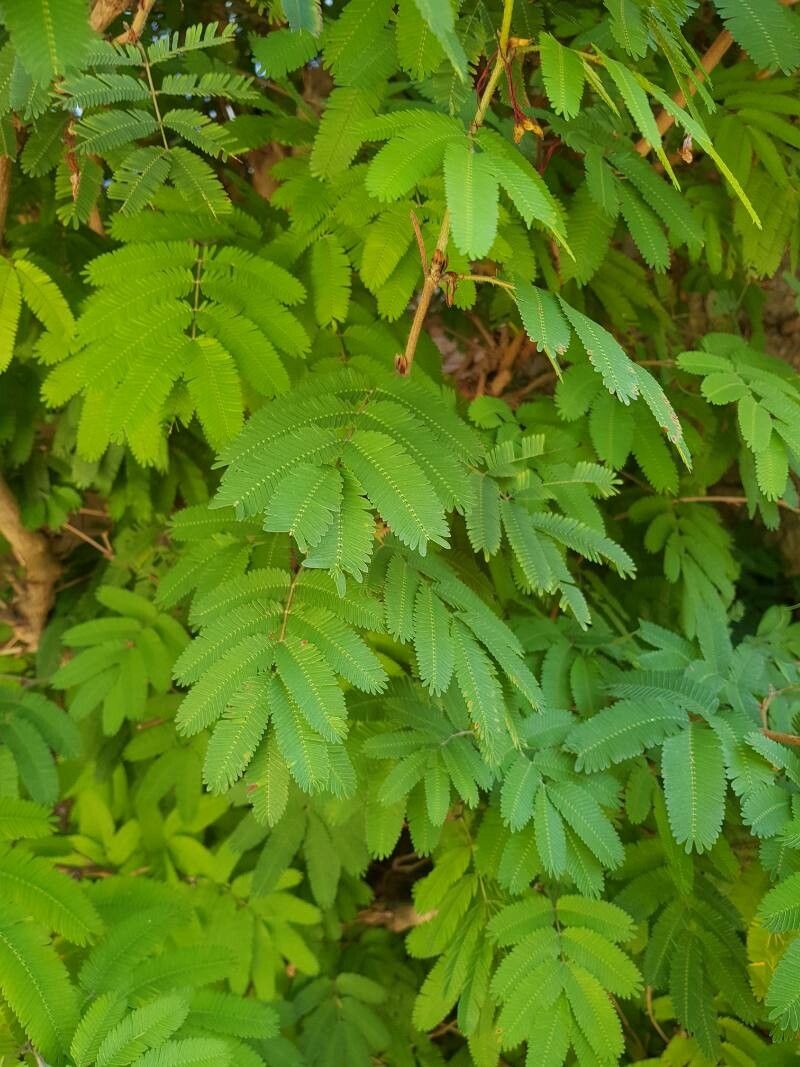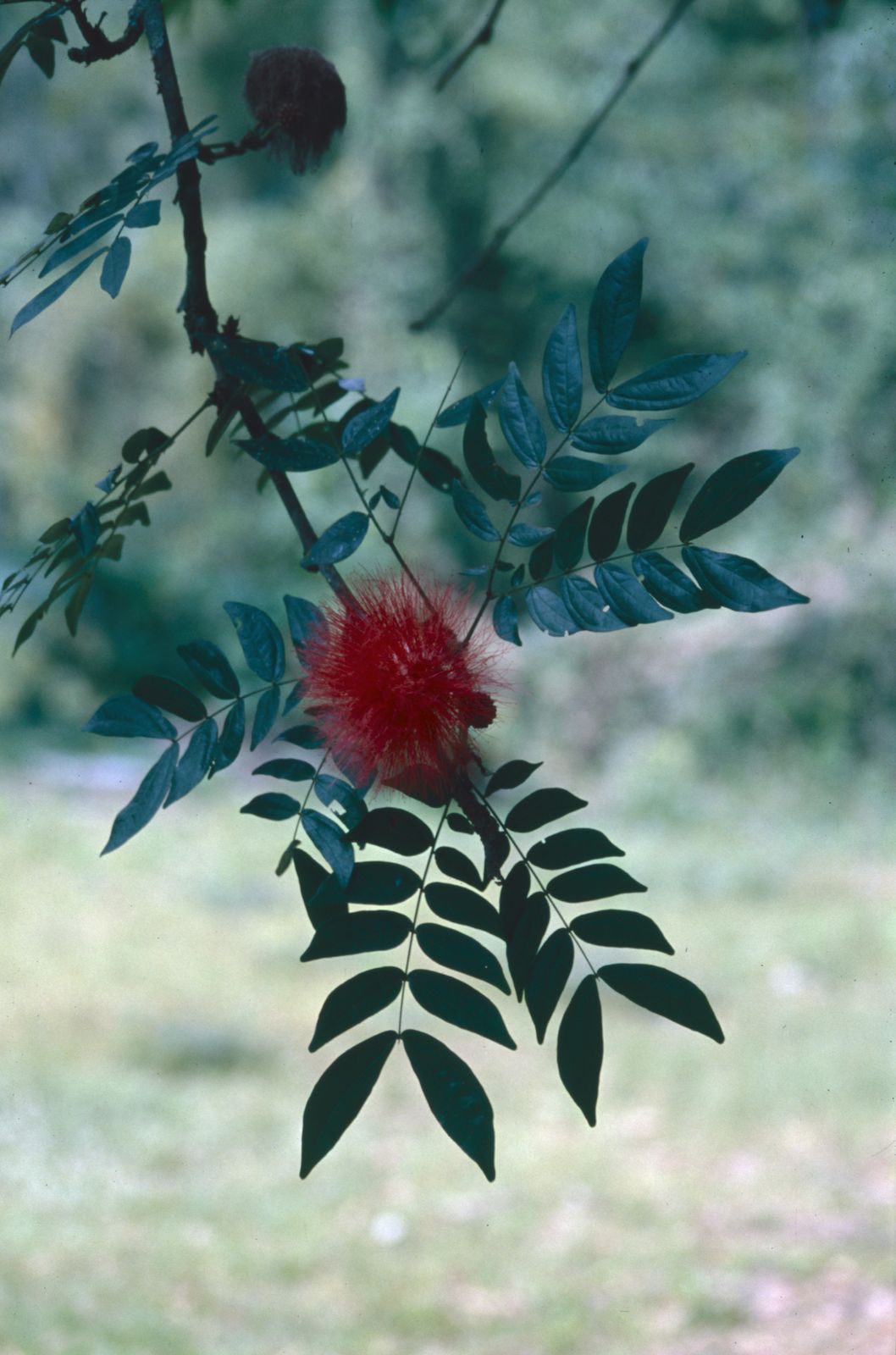Red Powder Puff
calliandra haematocephala
Also known as: ["Powder Puff Tree","Red Mimosa"]
Overview
A deciduous shrub or small tree known for its striking, fluffy red flowers that resemble powder puffs.
Benefits & Perks
["fragrant flowers","wildlife attractant (bees, butterflies, birds)","aesthetic foliage"]
Botanical Classification
| Phylum: | Magnoliophyta |
| Class: | Magnoliopsida |
| Order: | Fabales |
| Family: | Fabaceae |
| Genus: | Calliandra |
| Botanical Name: | Calliandra haematocephala |
Plant Characteristics
Basic Information
- Category: Flowers
- Suitable Location: outdoor garden in warm climates, or indoor pot in cooler regions
- Suitable For:
- Is Weed: No
- Allergenicity: low
Environmental Needs
- Climate: {"temperatureRange":"15–30°C"}
- Hardiness: {"zones":"9–11"}
- Misting: every 2–3 days in dry climates, less often in humid environments
- Drainage: Fast-draining to prevent waterlogging.
- Soil Type: Well-draining potting mix with added perlite or sand; can include some organic matter for fertility.
Maintenance Level
- Maintenance Level: moderate
- Toughness Level: moderate
- Pruning Frequency: Annually in late winter or early spring before new growth begins.
- Pruning Intensity: Moderate; remove up to one-third of the oldest stems to rejuvenate the plant.
Care Details
Ideal Sunlight Coverage:
Bright indirect light for 6–8 hours daily; can tolerate some direct morning sun but avoid harsh afternoon sun.
Sunlight Tolerance Tips:
Gradually acclimate the plant to direct sunlight to prevent scorching; place in a spot with filtered light if outdoors; indoors, position near an east or west-facing window.
Care Requirements
Care Difficulty
moderatemoderate
Sunlight
full sun to partial shade
Rotate plant weekly for even growth; use sheer curtains to filter intense sunlight; avoid placing near south-facing windows in summer.
Watering
every 7–10 days during active growth, reduce in winter
Water thoroughly until it drains from the bottom, allow soil to dry slightly between waterings, avoid letting the plant sit in water.
Soil
well-draining, fertile soil with organic matter
pH: Slightly acidic to neutral (pH 6.0–7.0).
Use a cactus or succulent mix as a base; avoid heavy clay soils; ensure pots have drainage holes.
Temperature
Prefers 65–85°F (18–29°C); can tolerate brief dips to 50°F (10°C) but thrives in warm conditions.
Protect from frost; avoid placing near air conditioning vents; maintain consistent temperatures to prevent stress.
Fertilizing
every 4–6 weeks during growing season, none in winter
Always water before fertilizing to prevent root burn; flush soil occasionally to prevent salt buildup; apply fertilizer to moist soil.
Propagation
Methods
Stem cuttings in spring or early summer.
Step-by-Step Propagation Guide
- Take a 4–6 inch cutting with at least two nodes.
- Remove lower leaves.
- Dip in rooting hormone.
- Plant in moist medium.
- Keep humid and warm.
Best Time: Spring or early summer when the plant is actively growing.
Environment
Warm, humid environment with indirect light; maintain temperatures around 70–75°F (21–24°C).
Medium
Well-draining potting mix with perlite or sand; can also use water propagation for initial rooting.
Hormone
Rooting hormone is recommended to improve success rates.
Timeline
Roots typically form in 3–6 weeks; new growth may appear in 2–3 months.
Tools Needed
Pruning shears, rooting hormone, small pots, well-draining medium, plastic bag or propagator.
Quick Tips
Keep cuttings out of direct sun; maintain high humidity; check for root development after 3 weeks.
Pruning & Repotting
Pruning Guide
Method
Selective pruning to shape the plant; cut just above a leaf node or bud.
Pruning Plan
Prune to maintain shape, encourage bushier growth, and remove dead or overgrown branches.
Tools
Pruning shears, sharp knife, disinfectant.
Checklist
Disinfect tools; prune before flowering; remove dead or diseased wood; shape the plant evenly.
Repotting Guide
Best Season
Early spring before the growing season begins.
Pot Size
Increase pot size by 2–3 inches in diameter; ensure the new pot has drainage holes.
Method
Remove plant gently; trim any circling roots; place in a slightly larger pot with fresh, well-draining soil; water thoroughly after repotting.
Suggestions
Repot every 2–3 years or when roots fill the pot; beneficial for root health and growth.
Checklist
Choose appropriate pot size; prepare fresh soil mix; handle roots carefully; water after repotting.
Advanced Care Tips
Watering Mastery
Watering Checklist
Check soil moisture before watering; water thoroughly; ensure proper drainage; adjust frequency based on season.
How to Apply Water Properly
Water at the base of the plant, ensuring moisture reaches the root zone; water early in the morning or late in the evening to minimize evaporation; ensure excess water drains away to prevent waterlogging.
Watering Schedule Tips
Water deeply once the top inch of soil feels dry; reduce frequency in winter to prevent root rot.
Soil Improvement
Add perlite or coarse sand to improve drainage; incorporate compost for fertility; ensure soil is loose and airy.
Temperature Stress Management
Signs of Temperature Issues
Yellowing leaves, leaf drop, or stunted growth in cold; wilting or leaf scorch in excessive heat.
Cold Stress
Low temperatures slow growth and can cause leaf drop; prolonged cold may lead to root damage or death.
Solution: Move plant indoors or to a sheltered location; provide a heat source if temperatures drop below 50°F (10°C); avoid cold drafts.
Hot Stress
Excessive heat can cause wilting, leaf scorch, or premature flower drop; may also increase water demand.
Solution: Provide shade during peak heat; increase watering frequency; use mulch to retain soil moisture; ensure good air circulation.
Fertilizing Guide
Fertilizing Checklist
Use diluted fertilizer; fertilize during active growth; avoid over-fertilizing; stop in winter.
Fertilizing Method
Use a balanced liquid fertilizer diluted to half strength every 4–6 weeks during the growing season (spring and summer); reduce or stop in fall and winter.
Common Problems & Solutions
Toxicity Warning
Cats
Slightly ToxicCats may experience mild gastrointestinal symptoms if they ingest the seeds or pods of Calliandra haematocephala. The plant is not considered highly toxic to cats but can cause mild irritation.
⚠️ Symptoms:
🌿 Toxic Parts:
⚡ Toxic If:
if eaten
Dogs
Slightly ToxicIn dogs, ingestion of Calliandra haematocephala seeds and pods can lead to mild gastrointestinal upset. The plant is not highly toxic but can cause discomfort if consumed in significant quantities.
⚠️ Symptoms:
🌿 Toxic Parts:
⚡ Toxic If:
if eaten
Humans
Slightly ToxicCalliandra haematocephala contains compounds that can cause mild gastrointestinal distress when ingested. The seeds and pods are the primary toxic parts, containing substances that may irritate the digestive tract.
⚠️ Symptoms:
🌿 Toxic Parts:
⚡ Toxic If:
if eaten
Frequently Asked Questions
Q: How often should I water Calliandra haematocephala?
A: Water moderately, allowing the soil to dry slightly between waterings. Increase watering during flowering periods.
Q: Does Calliandra haematocephala require full sun?
A: Yes, it thrives in full sun to partial shade, with at least 6 hours of direct sunlight daily.
Q: Can Calliandra haematocephala be grown indoors?
A: It is primarily an outdoor plant, but can be grown indoors in a very bright, sunny location with good air circulation.
Quick Reference
| Family: | Fabaceae |
| Care: | moderate |
| Light: | full sun to partial shade |
| Water: | every 7–10 days during activ |
Get Expert Care Tips
Download the Plantious app for personalized care reminders and plant identification!
Google Play App Store








